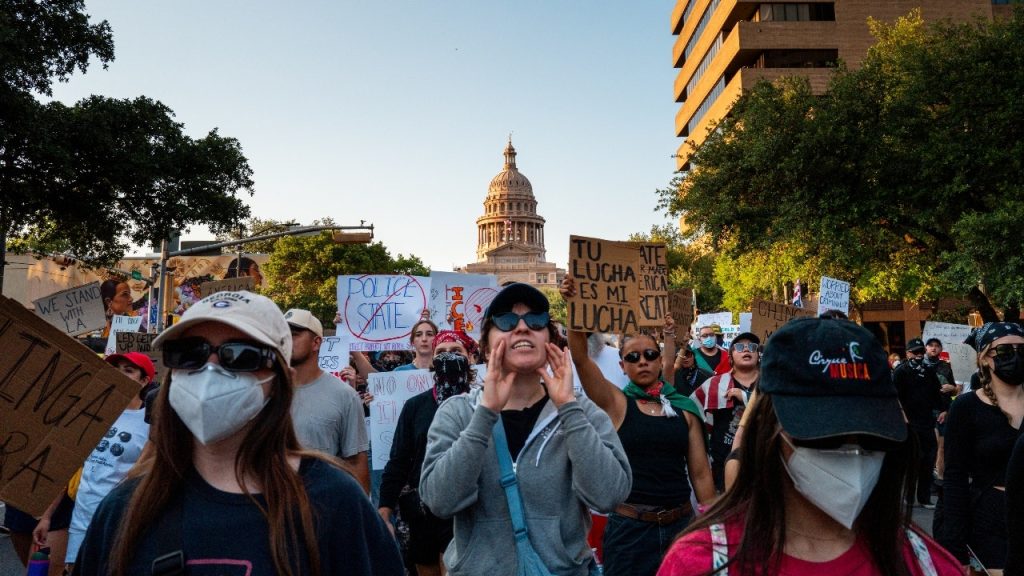The Austin Police Department (APD) has announced the arrest of eight individuals following violent protests against Immigration and Customs Enforcement (ICE) in Austin, Texas. The unrest began in Los Angeles on June 7 and has since spread to other cities, resulting in clashes between demonstrators and law enforcement. The protests escalated in Austin on June 8, leading to property damage, injuries to law enforcement officers, and multiple arrests.
| Article Subheadings |
|---|
| 1) Overview of the Protests |
| 2) Details of the Austin Incident |
| 3) Police Response and Community Impact |
| 4) Legal Consequences for Detainees |
| 5) Broader Implications for National Protests |
Overview of the Protests
The wave of protests against ICE began in Los Angeles on June 7, following severe backlash against recent raids that targeted undocumented immigrants. These demonstrations, initiated partly by local community groups, aimed to raise awareness regarding the treatment of immigrants and the policies enacted by the federal government. As tensions rose, these protests quickly turned violent, leading to chaos that saw properties vandalized, physical confrontations between protestors and law enforcement, the burning of vehicles, and widespread disruption to normal activities.
The unrest in Los Angeles triggered similar actions in cities across the nation, causing authorities in various regions to brace for potential violence. Austin was one of the cities markedly affected, with solid turnouts reported in demonstrations planned in response to the situation in California.
Details of the Austin Incident
The Austin protests commenced at the Texas State Capitol on the evening of June 8, where activists gathered to express their opposition to ICE’s operations. The crowd grew as it moved through downtown Austin, eventually arriving at the J.J. Pickle Federal Building. This location then became the focal point of vandalism, with demonstrators reportedly defacing property with graffiti and escalating the unrest further.
According to reports from the APD, the situation deteriorated as demonstrators began throwing objects, rocks, and even spitting at law enforcement officers. In response, officers issued dispersal orders while attempting to contain the unruly crowd. However, the protesters did not comply, leading to violent confrontations that necessitated additional law enforcement measures, including the deployment of tear gas and pepper spray.
Police Response and Community Impact
In light of the violence, the APD maintained its commitment to transparency and public safety, clearly stating that while they support lawful protests, they will not tolerate unlawful actions that endanger community members or officers. By the end of the confrontation in Austin, eight people were arrested, and a total of four police officers sustained injuries, with some requiring hospitalization.
The injuries to law enforcement heightened concerns about public safety and prompted a reassessment of how such protests should be managed in the future. Governor Greg Abbott voiced strong support for law enforcement personnel and stated that Texas was ready to deploy the National Guard if needed in response to further unrest, emphasizing a zero-tolerance policy for violence and property damage.
Legal Consequences for Detainees
The individuals arrested during the Austin protests face various charges, including criminal mischief, rioting, and harassment of public officials. This legal fallout raises questions about the implications of such actions on the protesters’ future. With charges pending, these individuals may face significant penalties depending on the outcomes of any ensuing legal proceedings. The case underscores the tension between the right to protest and the limits imposed by law enforcement in maintaining order.
As the situation unfolds, many anticipate that the legal ramifications will resonate beyond individual cases, potentially influencing broader political discourse and future policy on immigration and law enforcement practices.
Broader Implications for National Protests
The events in Austin are part of a larger national phenomenon, wherein protests against ICE policies have spread across many major cities. Demonstrators from different backgrounds are uniting under a common cause, sparking a nationwide conversation on immigration rights and systemic injustices. The mayhem in Los Angeles and Austin has drawn significant media attention, prompting discussions in various political arenas about how best to manage the conflict between protest rights and public safety.
Upcoming demonstrations in solidarity with Los Angeles have been scheduled in several cities. Authorities are preparing for potential escalations, taking cues from the recent upsurge of violence observed in Austin and elsewhere. The role of law enforcement in these upcoming events is under scrutiny, with many advocating for a balanced approach that safeguards the rights of protesters while also ensuring the safety of the public and law enforcement personnel.
| No. | Key Points |
|---|---|
| 1 | Eight individuals were arrested in Austin following violent protests against ICE. |
| 2 | The protests, beginning in Los Angeles, have inspired similar demonstrations nationwide. |
| 3 | APD committed to transparency but emphasized no tolerance for unlawful actions. |
| 4 | The Texas National Guard is on standby to respond to ongoing unrest. |
| 5 | Legal consequences for protesters could change the discourse regarding immigration and law enforcement. |
Summary
The ongoing unrest across the United States highlights the contentious debate surrounding immigration policies and the actions of ICE. With protests escalating and leading to violence in cities like Austin and Los Angeles, the response from law enforcement continues to evolve. As the situation develops, future protests and law enforcement preparedness will play critical roles in shaping public discourse on immigration and community safety.
Frequently Asked Questions
Question: What triggered the recent protests against ICE?
The protests were primarily triggered by ICE raids targeting undocumented immigrants in Los Angeles, which prompted demonstrations calling for the protection of immigrant rights.
Question: What measures did law enforcement take during the Austin protests?
Law enforcement issued dispersal orders, used tear gas and pepper spray, and made multiple arrests to restore order during the violent protests in Austin.
Question: What legal charges are the arrested individuals facing?
The arrested individuals face charges including criminal mischief, harassment of public officials, and rioting, among others, depending on their specific actions during the protests.
